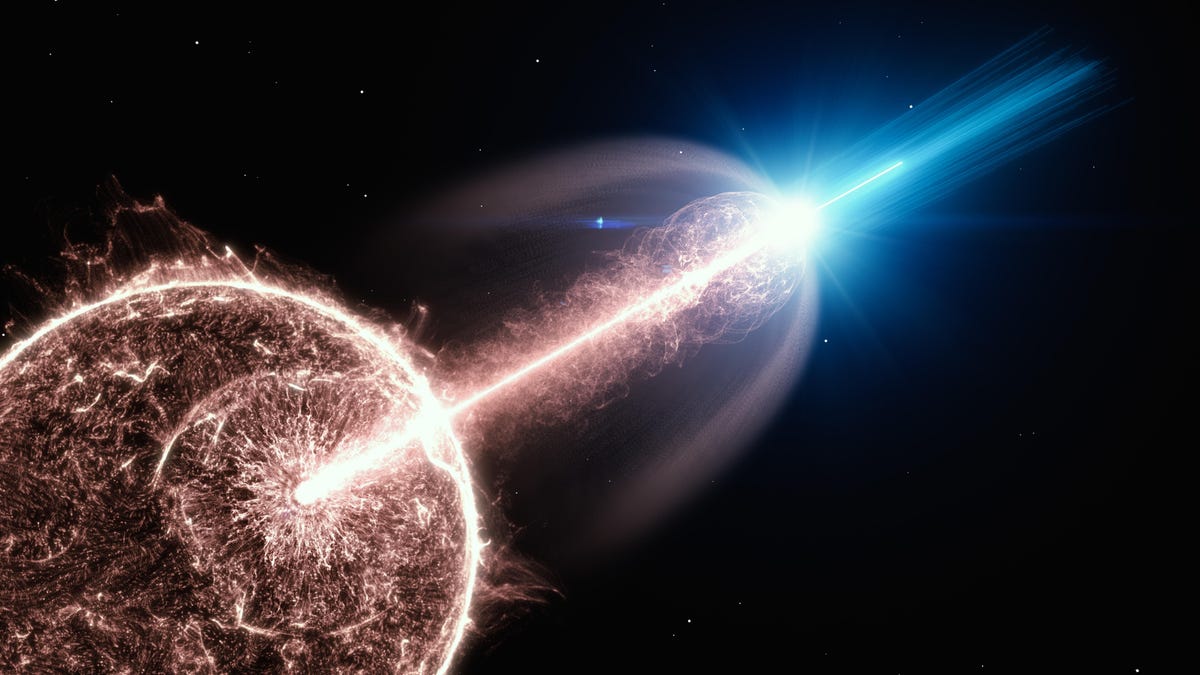Collapsing star produces one of the most epic cosmic explosions ever seen
Astronomers picked up a nearby (relatively speaking) gamma-ray burst from a stellar explosion.

Artist's impression of a relativistic jet of a gamma-ray burst breaking out of a collapsing star and emitting very-high-energy photons.
When some stars die, they collapse and go supernova, creating bright flashes of gamma rays and X-rays known as gamma-ray bursts. GRBs are thought to be the biggest explosions in the universe, and now scientists have observed one closer than ever before, leading to a surprise that challenges our understanding of the massive blasts that can also give birth to black holes.
NASA's Fermi and Swift satellites detected a gamma-ray burst in the direction of the constellation Eridanus on Aug. 29, 2019. It was catalogued as GRB 190829A, and almost immediately observatories around the world automatically shifted to collect more data on the cosmic event.
It turned out to be about a billion light-years away -- a comfortable distance to watch the very violent show, but about 20 times closer to Earth than the typical GRB.
"We were really sitting in the front row when this gamma-ray burst happened," said Andrew Taylor of the German research center Deutsches Elektronen-Synchrotron in a statement.
A GRB comes in two phases: an initial chaotic blast wave typically lasting less than a minute or so, followed by a slowly fading afterglow that can remain observable for days. Taylor reports that the second phase of GRB 190829A could be observed "for several days and to unprecedented gamma-ray energies."
The record-breaking energetic radiation scientists observed is likely due to the relative nearness of the GRB.
Current understanding of GRBs has presumed that the X-rays and gamma rays observed from such bursts are produced by separate mechanisms involving different types of colliding particles (think a particle accelerator on Earth). However, the data from this unprecedented GRB points to its X-ray and gamma ray components actually being a result of the same mechanism.
"It is rather unexpected," says Dmitry Khangulyan from Rikkyo University in Tokyo.
Khangulyan and Taylor are among a number of co-authors on a paper about the find published Thursday in the journal Science. In the end, the takeaway from the record-breaking observation is that there's more to learn and understand about GRBs.
"Looking to the future, the prospects for the detection of gamma-ray bursts by next-generation instruments like the Cherenkov Telescope Array that is currently being built in the Chilean Andes and on the Canary Island of La Palma look promising," said Stefan Wagner, spokesperson for the High Energy Stereoscopic System, a specialized observatory in Namibia that was used to study GRB 190829.
And, of course, hopefully future GRB detections will continue to be many millions, if not billions, of light-years away from Earth.
Follow CNET's 2021 Space Calendar to stay up to date with all the latest space news this year. You can even add it to your own Google Calendar.

